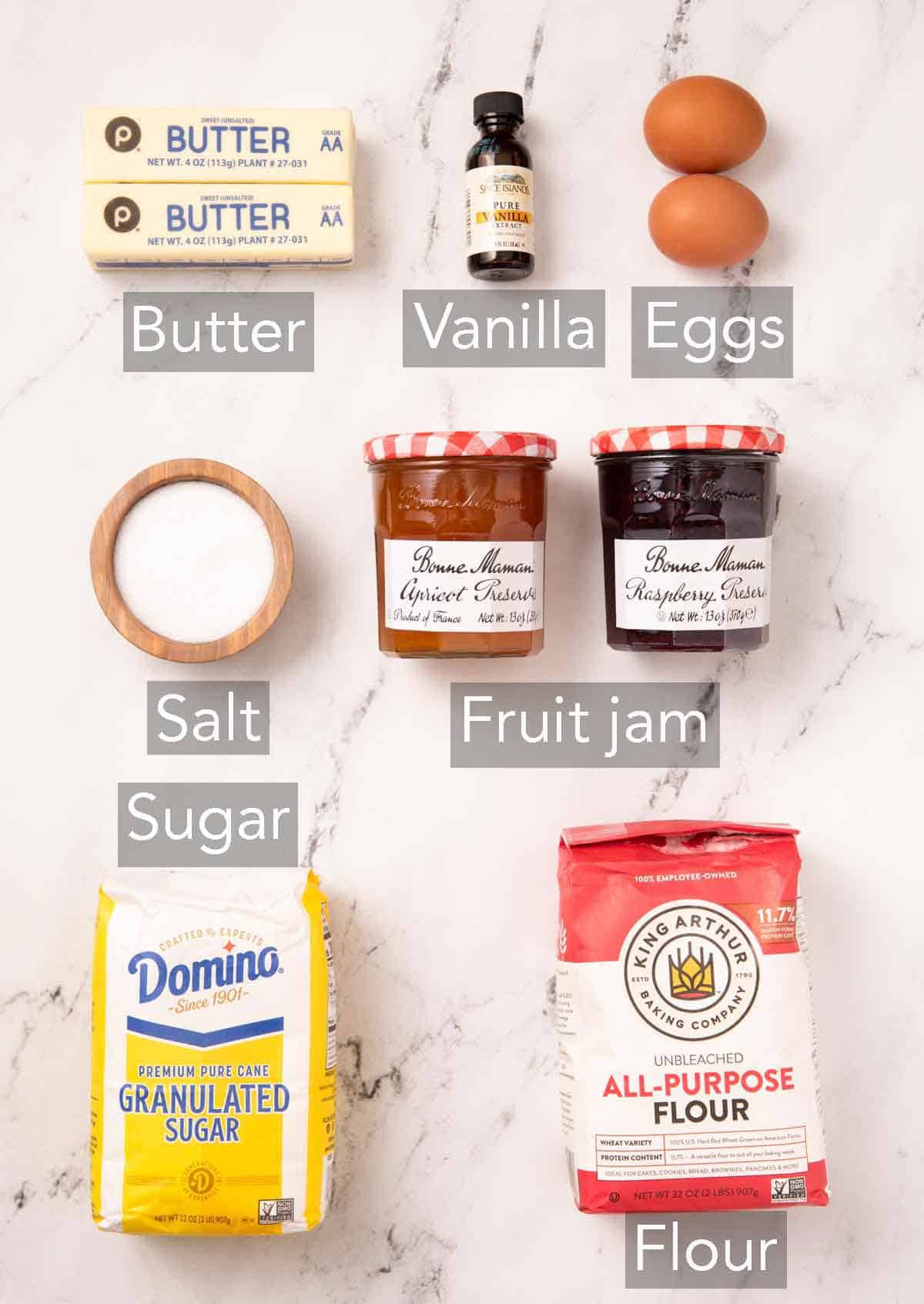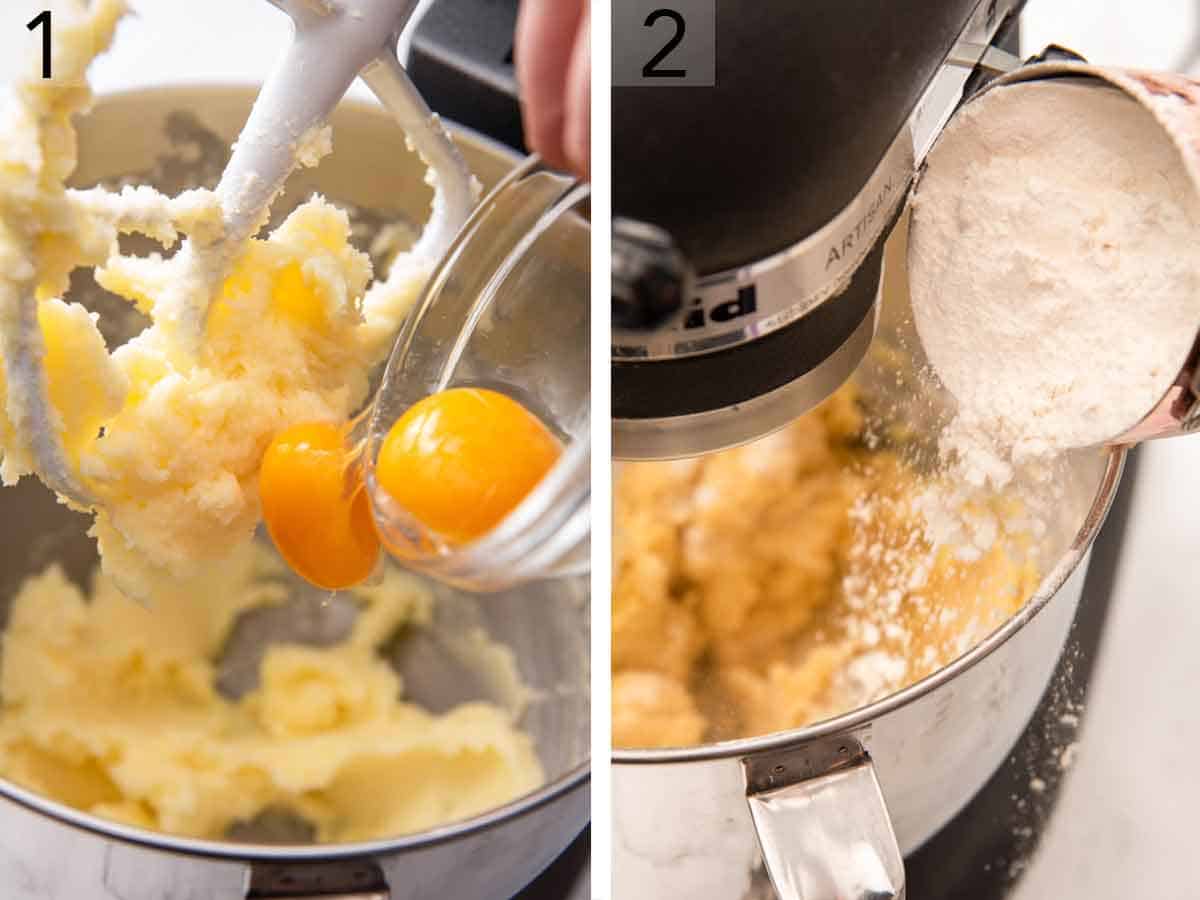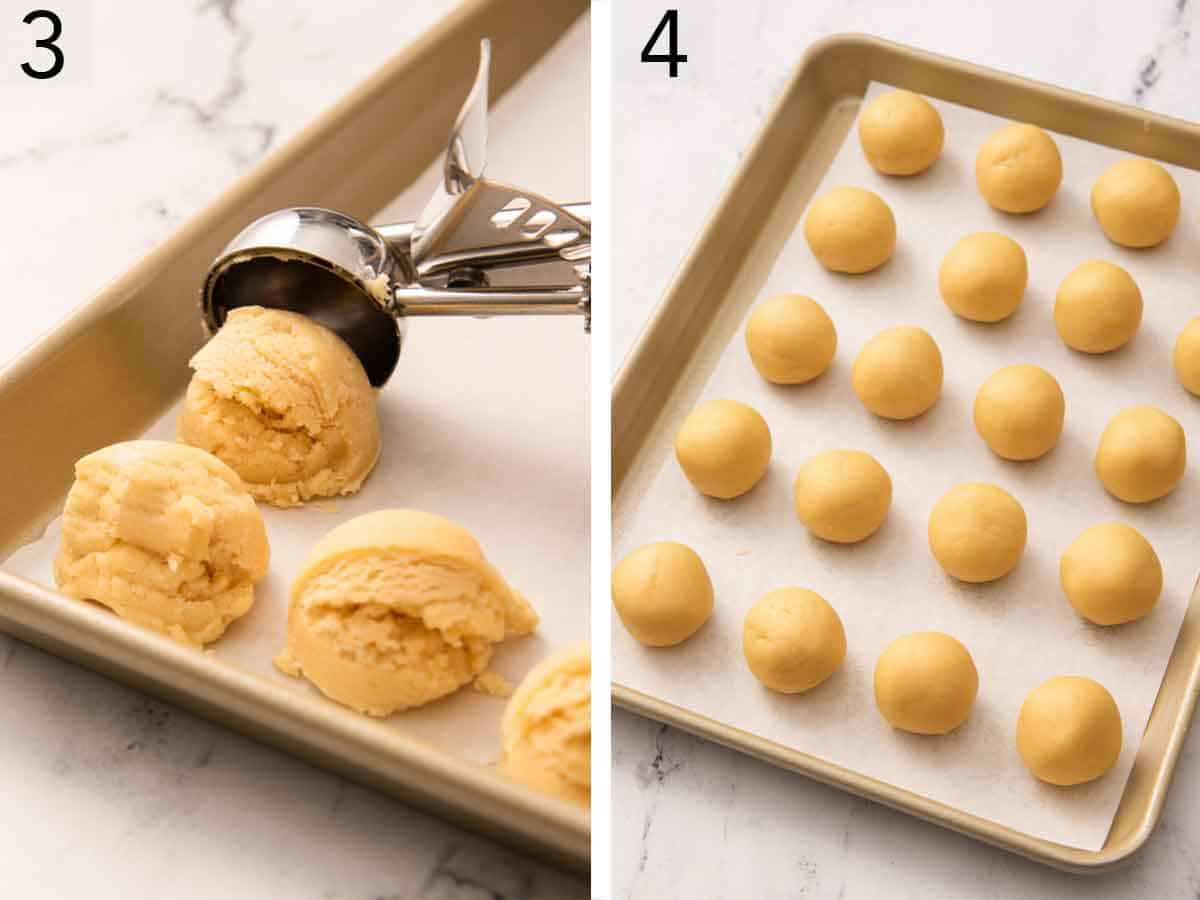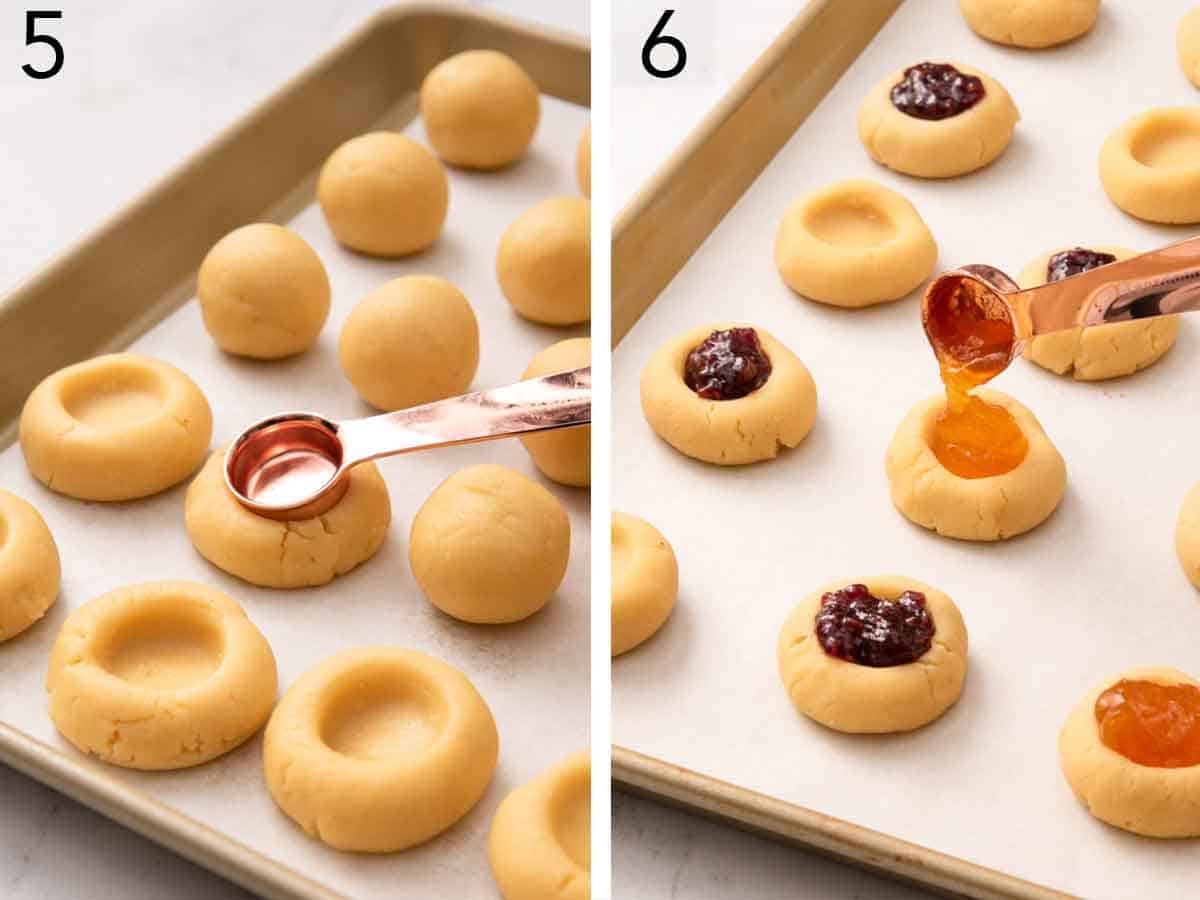Add a pop of color to your cookie tray this holiday season with these classic thumbprint cookies. These easy jam thumbprint cookies are a delightful bite-sized treat that everyone loves. They’re soft, chewy, and buttery, with a sweet jam-filled center that will make your mouth water.
They’re so easy to make and customize, as you can fill them with just about any flavor. You can even top the cookies with crushed nuts, powdered sugar, or a glaze drizzle to fancy them up. This classic thumbprint cookie recipe bakes the perfect cookie for a wonderful edible gift during the holidays and to have on hand for guests. If you want another holiday cookie recipe, then try my Grinch cookie recipe, rainbow cookies recipe, or chocolate biscotti recipe.
What You Need To Make This Recipe

Butter — make sure to use unsalted butter to keep the thumbprint cookies from tasting salty, as the amount of salt in salted butter can vary quite between different brands. These cookies have a rich, buttery taste, so I recommend using good-quality butter. Make sure the room temperature butter is soft enough so your finger leaves a dent when you press into it. If it’s cold and firm, it’ll be challenging to cream it.
Egg yolks — using just the egg yolks will give your cookies a lovely soft and chewy texture. Don’t throw the egg whites out, though! Save them for another recipe like my angel food cupcakes recipe.
Vanilla — a little bit of vanilla extract goes a long way. Check out my homemade vanilla extract if you want to learn to make your own.
Flour — I don’t recommend making substitutions to the flour. Stick with all-purpose flour for the best results.
Jam — use your favorite jam for the filling! I like using strawberry jam, raspberry jam, or apricot jam. A whole fruit jam works a bit better than jelly.
How to Make Thumbprint Cookies

1. In the mixing bowl of a stand mixer fitted with the paddle attachment, beat the butter and sugar together on medium speed until creamy. Add the egg yolks, vanilla, and salt, and beat until well combined.
2. While mixing on low, gradually add in the flour and beat just until combined. Stop and scrape down the bowl as needed during mixing.

3. Scoop the cookie dough into 1 tablespoon-sized balls.
4. Roll the dough into smooth balls between your palms.

5. Place on a parchment paper-lined cookie sheet or plate, and press your thumb or the back of a teaspoon into the center of each dough ball to create a cavity. Freeze for 30 minutes or refrigerate for 1 hour.
6. Working with one sheet at a time, place the frozen dough on the cookie sheet 2 inches apart. Fill with about ½ teaspoon of jam. Bake cookies one sheet at a time for 12 to 14 minutes or until the edges are just starting to turn brown. Let cool completely on the baking sheet before transferring to a wire rack.
Do I Have To Chill The Dough?
Technically, no. Chilling the dough helps the cookies hold their shape and prevents large cracks that form when they spread. If you don’t have time to chill them, you can bake them straight away, but keep in mind that they may spread more, and if large cracks do form, the jam can leak out.
Variations
- Roll in sugar: Before pressing the well in the center, roll each dough ball in granulated sugar. Or, for a festive look, roll them in colorful sanding sugar.
- Press different shapes: You can use small stamps or the end of a small spoon or chop sticks to form other shapes in the center, like hearts!
- Drizzle with a glaze: Finish off the cooled cookies with a little drizzle of glaze. Try the citrusy glaze from my lemon cookies.
- Fill with lemon curd: Swap the jam in the center for bright lemon curd.

Pro Tips for Making This Recipe
- If the dough cracks a bit when making the center indentation, roll the ball of dough in your palms a bit longer to warm the dough up more.
- Don’t skip chilling the dough if possible. Chilling the dough will make shaping it into balls easier and hold them together so they won’t fall apart when indented.
- Measure your flour correctly! Adding too much flour to the recipe is the most common mistake that will yield dry and dense cookies. The best and easiest way to measure flour is by using a digital scale. If you don’t have one, fluff your flour with a spoon, sprinkle it into your measuring cup, and use a knife to level it off.
- If you only have one baking sheet, make sure it has cooled thoroughly before adding the second batch of thumbprint cookies. A cool cookie sheet will help prevent the cookies from spreading.
- If you’re having difficulty filling the indent with jam, you can transfer the jam to a piping bag to pipe the jam into the cookies.
- Be careful not to over-whip the butter and sugar. Overwhipping the butter can cause the cookies to spread because it incorporates more air. While in many recipes, you want to beat the two together until light and fluffy, for these cookies, you just want the mixture to be creamy and well combined.

Frequently Asked Questions
I don’t recommend it. If you’re looking for a cutout cookie dough, try my sugar cookie recipe!
Make sure you roll the cookie dough balls into a smooth round ball. If there are cracks on the balls, then they’re more likely to crack as you indent them. Also, avoid waiting too long after rolling them to indent them. As the dough sits, the exterior starts to dry out, which increases the chances of cracking. If any cracks do form after pressing the indention in the center, press the crack back together before filling and baking.
Your cookies may spread if you skip chilling them, add too little flour to the batter, or if you grease the baking sheets. Make sure you chill your dough, as it also helps keep the cookies from cracking and weigh your ingredients to ensure the measurements are accurate. Also, line your sheet pan with parchment to avoid them from sticking to the pan instead of greasing it.
Store thumbprint cookies in an airtight container for up to 1 week. You can keep them at room temperature or in the fridge.
You can! Freeze the cookies in an airtight freezer-safe container for up to 2 months. Place a layer of parchment or wax paper between the cookies to keep them from sticking. Bring them back to room temperature before enjoying them.
If you’ve tried this Thumbprint Cookies recipe, then don’t forget to rate the recipe and let me know how you got on in the comments below, I love hearing from you!

Thumbprint Cookies Recipe
Video
Equipment
- Mixer
Ingredients
- 1 cup unsalted butter softened (227g)
- ¾ cup granulated sugar (150g)
- 2 large egg yolks
- 1 teaspoon vanilla extract
- ½ teaspoon salt
- 3 cups all-purpose flour (360g)
- ⅓ cup fruit jam (strawberry, raspberry, or apricot jam)
Instructions
- In a large mixing bowl or the bowl of a stand mixer fitted with the paddle attachment, beat the butter and sugar together on medium speed until creamy, about 1 minute.
- Add the egg yolks, vanilla, and salt, and beat until well combined. While mixing on low, gradually add in the flour and beat just until combined. Stop and scrape down the bowl as needed during mixing.
- Scoop the dough into 1 tablespoon-sized balls and roll into smooth balls between your palms. (If desired, toss in granulated sugar to coat the outside.) Place on a parchment- or wax paper-lined sheet or plate, and press your thumb or the back of a teaspoon into the center of each dough ball to create a cavity. (Press any cracks back together.) Freeze for 30 minutes or refrigerate for 1 hour.
- Preheat the oven to 375F. Line two large baking sheets with parchment paper.
- Working with one sheet at a time, place the frozen dough on the cookie sheet 2 inches apart. Fill with about ½ teaspoon of jam. (Thumbprints should be very full but not overflowing.)
- Bake one sheet at a time for 12 to 14 minutes or until the edges are just starting to turn brown. Let cool completely on the baking sheet. Store in an airtight container for up to 1 week.
Notes
- If the dough cracks a bit when making the center indentation, roll the ball in your palms a bit longer to warm the dough up more.
- Don’t skip chilling the dough. Chilling the dough will make shaping it into balls easier and hold them together so they won’t fall apart when indented.
- Measure your flour correctly! Adding too much flour to the recipe is the most common mistake that will yield dry and dense cookies. The best and easiest way to measure flour is by using a scale. If you don’t have one, fluff your flour with a spoon, sprinkle it into your measuring cup, and use a knife to level it off.
- If you only have one baking sheet, make sure it has cooled thoroughly before adding the second batch of thumbprint cookies to them. A cool cookie sheet will help prevent the cookies from spreading.
- If you’re having difficulty filling the indent with jam, you can transfer the jam to a piping bag to pipe the jam into the cookies.
- Be careful not to over-whip the butter and batter. Overwhipping the butter can lead to the cookies spreading, and overmixing the batter can lead to dense cookies.














